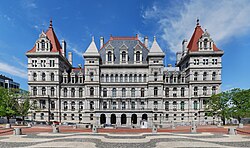This article needs additional citations for verification .(June 2019) |
New York State Legislature | |
|---|---|
 | |
| Type | |
| Type | |
| Houses | Senate Assembly |
| History | |
| Preceded by | General Assembly of New York |
| Leadership | |
| Structure | |
| Seats | 213 |
 | |
Political groups | Majority caucus
Minority caucus
|
 | |
Political groups | Majority caucus
Minority caucus
|
| Salary | $142,000/year + per diem |
| Elections | |
Last election | November 8, 2022 |
Next election | November 3, 2026 |
| Meeting place | |
 | |
| New York State Capitol Albany | |
| Website | |
| public | |
The New York State Legislature consists of the two houses that act as the state legislature of the U.S. state of New York: the New York State Senate and the New York State Assembly. The Constitution of New York does not designate an official term for the two houses together; it says only that the state's legislative power "shall be vested in the senate and assembly". [1] Session laws passed by the Legislature are published in the official Laws of New York . [2] [3] Permanent New York laws of a general nature are codified in the Consolidated Laws of New York . [2] [4] As of January 2021 [update] , the Democratic Party holds supermajorities in both houses of the New York State Legislature, which is the highest paid state legislature in the country.
Contents
- Leaders
- Drafting and research
- Party control
- Constitutional powers
- History
- Legislative leadership
- New York State Senate
- New York State Assembly
- See also
- References
- Further reading
- External links
Legislative elections are held in November of every even-numbered year. [5] Both Assembly members and Senators serve two-year terms. [6]
In order to be a member of either house, one must be a citizen of the United States, a resident of the state of New York for at least five years, and a resident of the district for at least one year prior to election. [7]
The Assembly consists of 150 members; they are each chosen from a single-member district. The New York Constitution allows the number of Senate seats to vary; as of 2014 [update] , the Senate had 63 seats. [8]


